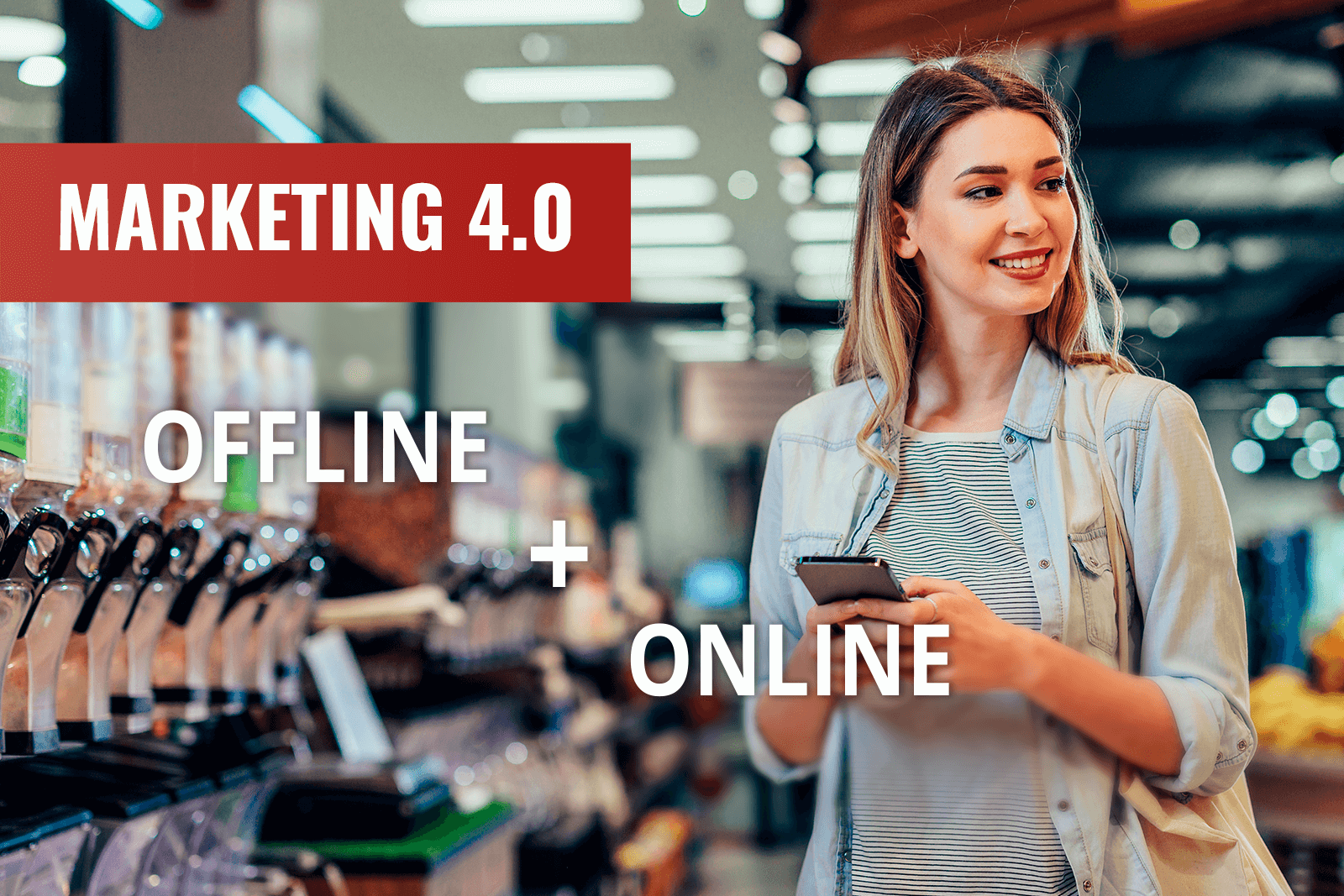Marketing 4.0 is a book by Philip Kotler co-authored with Hermawan Kartajaya and Iwan Setiawan. This work coins the concept of this new type of marketing, which is a combination of traditional marketing (which focuses on customer interaction) and digital (which focuses on driving action and promotion).
- Characteristics of marketing 4.0
- Marketing to the n:
- Artificial intelligence and marketing 4.0
- Conclusions
Characteristics of marketing 4.0
Philip Kotler is a marketer who could be considered the father of modern marketing. He has dedicated his life to the development of this discipline and in the last 40 years he has received multiple awards for his work. In the context of the digital economy, the authors of Marketing 4.0 refer to how the online interacts with the offline.
The intention of the book is to give marketers a guide to anticipate new technologies, such as artificial intelligence. In these new market conditions, marketers must rethink the concepts they have traditionally used.
The main characteristic of marketing 4.0 is that it is a combination between traditional media (such as the physical point of sale, television ads, radio, BTL…) and digital (e-commerce, online advertising , social media, etc.). Which makes us rethink how a customer interacts with the brand, what are their contact points, what is their journey towards the purchase…
In this type of marketing, the consumer is much better informed, they have more elements to make a purchase decision, such as the online reviews of other customers and the opinion of their friends about a product or service. For this reason, companies must be more transparent in their marketing and communication processes. It’s not enough for a brand to repeat its value proposition to be remembered by customers: now it has to keep that promise. Otherwise, customer loyalty is not achieved, which in this new economy is essential to get them to recommend us and increase our sales with that.
Marketing to the n
Surely marketing “versions” will continue to be renewed as markets evolve. At the moment we can think of a first stage of marketing, dating back many centuries. Some people trace its origin back to the 15th century, with the birth of the printing press, which allowed the massive dissemination of ideas and news. However, marketing began to be studied as a discipline until the 20th century and with the emergence of the Internet, it acquired new nuances referred to by the terms marketing 2.0, 3.0 and now 4.0.
Marketing 2.0
The term marketing 2.0 refers to a marketing evolution that took place with the arrival of social networks and web 2.0. At this stage, companies began to use digital platforms to interact and engage with their audience in a more direct and personalized way. Marketing 2.0 focuses on consumer engagement and building communities online, taking advantage of social networking tools, blogs, online videos, and other forms of user-generated content.
Marketing 3.0
For its part, marketing 3.0 is a concept that was developed later, and focuses on the importance of values and emotions in the relationship between the company and the consumer. It is based on the idea that companies must be aware of their social and environmental responsibility, and must use marketing as a way to do good and contribute to the well-being of people and the planet.
Differences between marketing 4.0, 3.0 and 2.0
Some of the concepts that marketers use, such as segmentation, targeting, positioning, customer journey, among others, have evolved in marketing 4.0. In the following table I expose some of the differences that Kotler highlights in his book.
| Concept | In the marketing 3.0 and 2.0 | In the Marketing 4.0 |
| Segmentation | Groups of people selected by marketers. Communication through a vertical relationship, without consent or participation of the customer. | They’re communities. Communication with them must be transparent, with the consent of the customer and through a horizontal relationship. |
| Targeting | The marketer decided the segments and communicated the offer. | It is the customer who decides what messages they want to receive and through which channels. |
| Positioning | They only repeated the value proposition and promise over and over again, as long as it was the number one brand remembered by customers. | It is necessary for the brand to keep up with its promise, if it does not, it loses the trust of customers. More than being the top of mind, loyalty is sought. |
| Marketing mix | It was focused on the product. It was defined by the 4 P’s: product, price, place and promotion. | Focuses on the customer. Now you also have to consider the 4C’s: customer, cost, convenience and communication. |
| Distribution of products and services | Vertical scheme: a bank grants a credit to a customer; a hotel rents a room to a customer. | Horizontal scheme: through Fintech, a person lends money to another; a person rents a room to another with Airbnb. |
| Customers | They concentrated easily. They listened to the offer of a brand, product or service. For this reason, marketers focused on the repetition of the message. | There are too many messages, so customers turn to trusted sources: people in their circle who recommend goods, products or services. For this reason, it is necessary to get clients who defend the brand, who recommend it. |
| Customer touch points | They were only physical. | They are also digital. |
| The customer’s focus on their purchase journey | Advertisers were focusing on the AIDA factors: Attraction, Interest, Desire, Action. | The new framework for understanding the customer is: AIDAA, which includes the heading of Acting again, that is, the relationship does not end with the purchase but rather makes it recurring or converts the buyer into a brand defender. |
| Conversion funnel | Clients went through the stages of: raising awareness, appealing, asking, acting, defending. | The funnels are not fixed, you can skip stages, expand or reduce, or work in a spiral. |
| In the purchase decision | There was social influence. | Social influence is higher. Recommendations are requested, online reviews are read, etc. before buying. |
| Measurement metrics | Marketers rarely saw the relationship between awareness and promotion. | This relationship can be measured by:
-Buying Action Index (PAR) -Brand Advocacy Index (BAR) There is a direct relationship between awareness, recommendation and purchase. This can be measured. |
| Personalization | It wasn’t that important. | Brands are more attractive as long as they offer products and services that adapt to the specific needs of each customer. |
| Customer commitment (engagement) | Multichannel experiences. One at the point of sale, another online… | Omnichannel experiences. The experiences at each touch point are connected to each other. You can start a purchase process on your mobile and finish it in the store. |
Artificial intelligence and marketing 4.0
Marketing 4.0 is influenced by digitalization, connectivity, and the advancement of technology. In this context, artificial intelligence (AI), which is the ability of machines to perform tasks that a human would normally do, is gaining relevance. The relationship that marketing today has with these AI tools is reflected in tasks such as:
- Creation and analysis of data that help us better understand target audiences and markets.
- Personalization to offer each customer precisely, products or services that are useful. For example, Amazon’s personalized recommendations.
- Chatbots that interact with users and provide answers to frequently asked questions from potential customers.
- Automation of various aspects of marketing, because although human creativity will always be necessary, we now have tools that automatically perform tasks for us such as sending emails, generating reports in real time, among others.
- According to the Marketing 4.0, authors, traditional marketing is still important. The new evolution of this discipline consists of a combination between online and offline.
- The convergence of new technologies, on the one hand, has empowered consumers by giving them more means to learn about companies’ production and distribution processes. This tips the balance in their favor, and it is something that large corporations cannot ignore.
- Transparency and ethics, keeping the promises they make… are paramount for brands in the new digital economy.
- New technologies, on the other hand, now provide more precise data to companies to understand their customers (current or potential) and carry out much more specific strategies.
- Artificial intelligence is driving a new industrial revolution in which marketing 4.0 is no stranger.
Want to know more about these topics? Contact us for a marketing consultancy.


